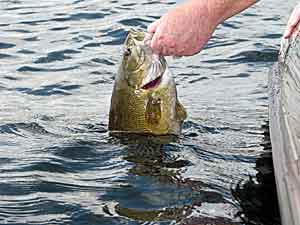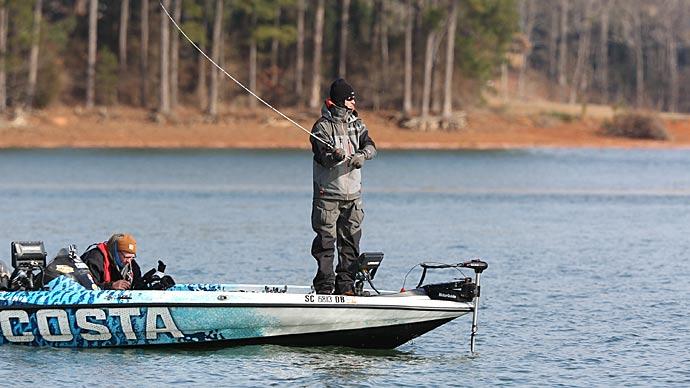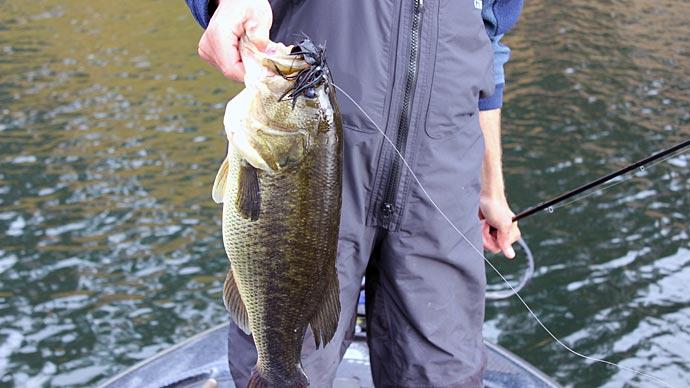
There are several reasons that a bass strikes a lure. These include instinct reaction, agitation, defense of territory, or because they are hungry or think they are hungry. I have often been asked by beginner anglers which of these are the most important. That's easy since striking in the protection of territory is limited to defending a nest. It, therefore, represents only a small window of time in the life of a female bass.
On the other hand, instinct reaction and feeding are interlocked as they are in most predators. Because it is my firm belief that these are the reasons that I catch most of my fish, I have spent a considerable amount of time studying what they eat and, likewise, the color and patterns of those creatures.
If I were to ask what you consider the most important type of food for bass, I should get an answer from a fisherman that returns the answer with a question. Or should I say questions of where? What time of year? And even some specific points like what time of day? And at what depth? Not to mention factors that add other complications, such as - what is the lake's size.
| "When you start planning a strategy for fishing for bass, run a checklist in your mind and try to envision what you think should be on the menu for the bass you will try to catch." |
Let's cheat a bit and seek the most likely answer that will get us the highest likelihood of being right, the highest percent of the time. The answer would be shad. Think about a natural hunting instinct among predators. Many prefer to hunt in packs, on abundant prey that is more likely to concentrate in large, easily preyed upon groups. This is not to say that a school of shad is without its defense. To begin with, there are many of them in a school, and an attacking group of bass will pick off some of the prey like a group of attacking lions, and the rest will survive by sheer numbers and, in the case of shad, their speed.
Not all shad are the same, though. On Lake 'O The Pines this winter, I worked in an area with large schools of shad, which showed up in deep water on my depth finder. It didn't take long to figure out why I had trouble getting hits on my jigging spoon. I was following masses of gizzard shad. These fish rapidly grow past the size that any but the largest bass will try to tackle. So obviously, I needed to find areas with their cousins, the threadfin shad.
These are the shad that tend to grow slowly and are the main table fare for bass. This is particularly so during the periods of the year when baitfish establish reproducible patterns and in the summer when the schooling of shad may occur at various depths, which is usually only limited by a lack of oxygen in certain parts of the lake. In the summer, this absence of shad below a given depth may be due to the lake's stratification into specific depths below which there is an oxygen deficiency. If the lake's surface is relatively calm during the day, shad will often school on the surface, even over deep water. This instinct for shad to "run" on the top is an instrumental observation in shallower parts of the lake since they tell you that if there is enough oxygen for them, there's enough for bass in the same area.
Of course, all you have to do in the summer, or when the shad are bunched in deep water in the winter, is to use a shad-type bait or spoon, and you are in business if it was only that simple. In the real world, you can count on assured action if the bass indeed are on shad, but likewise, they often shift onto another food source and go off of the shad. This can be best typified by the fact that an area of aggressively feeding bass will give constant action all afternoon and then suddenly shut down at dark. I have spent many an hour trying to force a bunch of the "old faithful" into continuing to hit cranks in the areas where I know they are still located, but the only difference is that the sun has set. They can be caught, but usually, I have to switch to soft plastics. This has to mean that the school is no longer feeding as a school on shad, but loners will, if forced, occasionally hit a topwater bait.
Are shad the most useful table fare in providing forage that enables the bass population to increase in size and numbers? From the standpoint of several commercial fish farmers, I have been told that Koi carp are excellent forage for producing rapid growth and providing a population of bass which are in excellent condition and reach reproductive maturation rapidly.
So how many folks think carp in a lake is a good forage? You might rationalize that for a lot of the year, there are probably few carp in the wild that are the right size for bass to forage. But, on the other hand, there are, during the spring post-spawn periods, a lot of newly hatched carp, and not by accident, the bass will fall for a gold or bronze-colored crank during this period.
When considering the forage that bass select, you must remember that these fish are opportunistic feeders. Simply put, if there is a lot of a particular type of bait in the right size and readily available, they are likely to feed on them, even if this is only for a short period where there is such abundance.
When selecting lures, recognize that a lake with threadfin shad will always have some bass feeding on them. But others will take advantage of periods of an abundance of other things. An example is brought home by the tendency of bass to work over crayfish during the spring shift to shallow water. This tracks just ahead of the spawning period of the bass, but the bass are shifting in and out of the areas in pre-spawn staging and will often be caught in much shallower water than you might expect by the water temperature.
A whole group of critters crawl or swim along the lake bottom. These include crayfish, tadpoles, and various reptiles and amphibians. Soft plastic baits and the jig-n-pig type plugs represent lures that are interpreted as food in this domain. Likewise, a slow-falling, soft plastic plug has an action like a wounded shad or bream. More often than not, fish caught on these lures may not actually be in a school but are on a pattern that places numbers in the same type of structure and/or depth simultaneously.
| "You must remember that these fish are opportunistic feeders." |
Speaking of patterns, we often fish for bass, which makes up what I consider individual fish. These bass are usually found as groups of two or even as loners. You are often pitching to individual stumps, the edge of vegetation, or working other types of patterns. This doesn't mean it can't produce numbers of fish just because the bass aren't bunched up, and the pattern worked on a given day. These fish are more likely to hit various items that enter their sanctuary. These fish are more prone to strike on instinct. If you think about it, if they wanted shad, they would be in the schools trying to herd them into the "diner."
If a shad comes into the loner's backyard, it is fair game, but on the other hand, shad aren't going to be out of school, to begin with. So often, these isolated bass will hit a shad-colored lure because there are many minnows in the area - essentially the same color as shad. Minnows will usually linger in the same type of cover that the individual fish seek, while shad are more likely to be in open water in less restricted areas, allowing ease of movement for the school.
Bream are another primary forage for bass. The first critical time when large numbers of bream are together is in the spawning period of the late spring or early summer. Since this often occurs after bass have spawned, these concentrations are a choice for hungry post-spawn bass. I have never seen bass feed on spawning bream schools, but I watched them patrol the edges of the beds and pick off a wayward sun perch. On the other hand, bream that bunch in deep channels after the first couple of fronts attract concentrations of bass that will feed on the bream in a manner similar to a tighter pattern of their school activity on shad.
Unlike schools of shad, bream will be next to structure most of the year and, therefore, in some of the same areas where bass spend periods away from schools. Scattered or individual bass, as mentioned before, are often fish feeding on things other than shad for most of the year. These same concepts apply to warm water conditions when fishing topwaters. A bream-colored bait may be of little value to schooling bass feeding on shad. On the other hand, scattered bass will hit either a shad color or an array of other colored baits. If you exclude shad when selecting a topwater, your main color mimics a bream or several dark-colored things that may land on the water and try to get away or swim to the bank.
When you start planning a strategy for fishing for bass, run a checklist in your mind and try to envision what you think should be on the menu for the bass you will try to catch. Of course, you will also have to factor in the time of year, the water depth you want to work, and if you expect to work schools or establish a pattern for working scattered bass.
Tied into this game plan should be using something similar in color to the forage in the area and what they will be doing (bait action should be replicated by your lure action). Working these factors into your plan will help you catch bass by focusing your efforts where they should be most productive.




